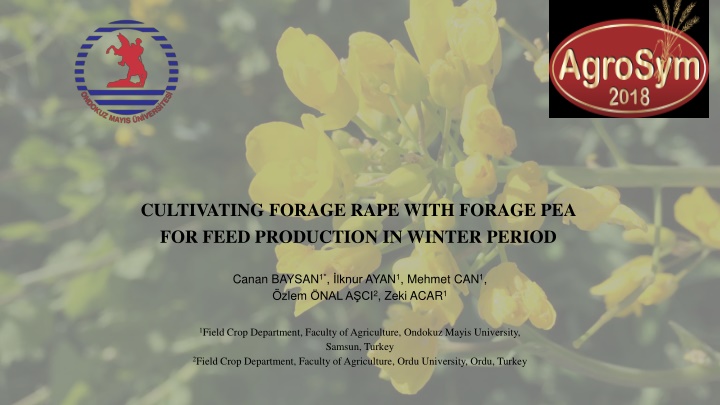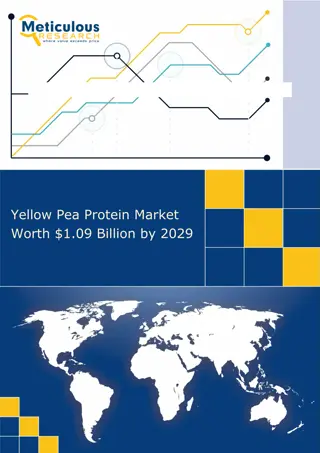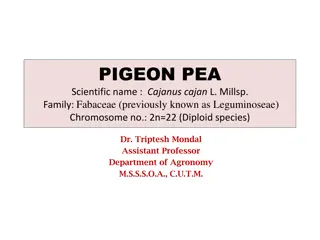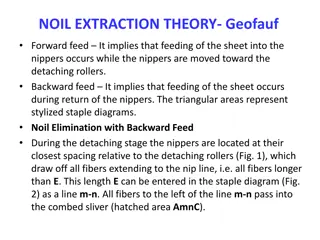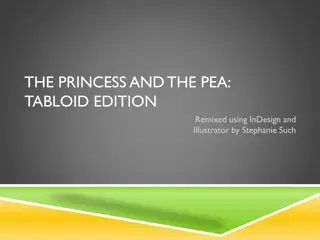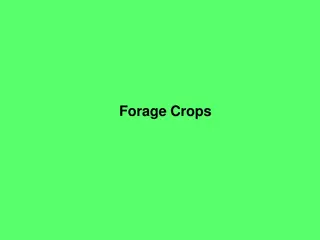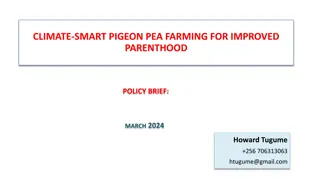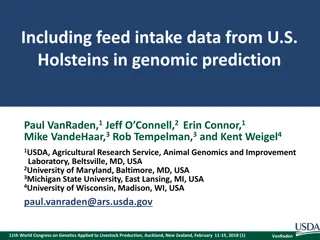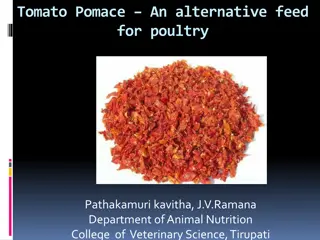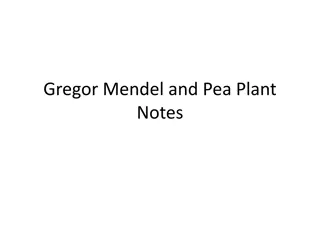Cultivating Forage Rape with Forage Pea for Winter Feed Production
Cultivating forage rape alongside forage pea provides a practical solution for feed production during the winter period. Forage rape, traditionally an oil crop, is now being utilized as fresh herbage, hay, or silage for ruminants. By mixing forage rape with forage pea, the detrimental effects of anti-nutritional compounds in rape tissues can be minimized, enhancing overall nutritional value. This study focuses on determining the best forage pea cultivar for optimal forage yield, quality, and the ideal growing stage when harvested along with forage rape.
Download Presentation

Please find below an Image/Link to download the presentation.
The content on the website is provided AS IS for your information and personal use only. It may not be sold, licensed, or shared on other websites without obtaining consent from the author.If you encounter any issues during the download, it is possible that the publisher has removed the file from their server.
You are allowed to download the files provided on this website for personal or commercial use, subject to the condition that they are used lawfully. All files are the property of their respective owners.
The content on the website is provided AS IS for your information and personal use only. It may not be sold, licensed, or shared on other websites without obtaining consent from the author.
E N D
Presentation Transcript
CULTIVATING FORAGE RAPE WITH FORAGE PEA FOR FEED PRODUCTION IN WINTER PERIOD Canan BAYSAN1*, lknur AYAN1, Mehmet CAN1, zlem NAL A CI2, Zeki ACAR1 1Field Crop Department, Faculty of Agriculture, Ondokuz Mayis University, Samsun, Turkey 2Field Crop Department, Faculty of Agriculture, Ordu University, Ordu, Turkey
CONTENTS CONTENTS Introduction Material and Methods Results and Discussion Conclusion Reference 2
Introduction Introduction There is scarcely less opportunity to increase agricultural lands in Turkey as well as in the world. However, on the other hand, population is growing day by day. In this case, we should use more effectively available agricultural areas. One of these ways is to apply mixed growing system. 3
Rape plants have a rapid growing ability and they can reach seed ripening period in 4-5 months. Even though, rape is mainly used as oil crop, recently forage rape farming start to increase in the aim of to meet forage gap. Forage rape can be used as fresh herbage, hay or silage to feed the ruminants. But, there are some anti-nutrients such as erucic acid, glucocids and nitrate in rape tissues. 4
In order to decrease detrimental effects of anti-nutritional compounds, forage rape can be grown mixed with other annual forage crops. Especially forage pea is very suitable to grow mixed with forage rape, because of its rapid growing ability, high yield and nutritional values. 5
The aim of this study is to determine the best suitable forage pea cultivar in terms of forage yield, quality and growing stage when harvested in budding and blossoming stage of forage rape. 6
Material and Methods Material and Methods The experiment was established according to randomized block design with 4 replicates. In the study, forage rape cv. Lenox, forage pea cv. G lyaz , cv. Tamko , cv. Ulubatl , cv. Kirazl (Turkey), cv. Kosmaj (Serbia), cv. Letin and cv. Adam (Croatia) were used. The study was carried out during 2017-18 growing season. 7
The study was carried out in Samsun during 2017-18 growing season. 8
Consider the soil sample analysis, 80 kg ha-1 phosphorus and applied the whole experiment. N fertilizer was separated in 2 parts, one part in sowing time, the other part in spring was distributed by hand. The amounts of N were 100 kg ha-1for solely forage rape plots 6 kg ha-1for mixed plots and 3 kg ha-1 for solely pea plots. There was no irrigation. Forage samples were analysed by using NIRS device. The data were statistically analyzed with SPSS program. 9
Results and Results and Discussion Discussion Forage rape cv Lenox started blossoming at 27.03.2018. Two forage pea cultivars Letin and Kirazl were earlier than cv Lenox 12 and 7 days, respectively. Forage pea cultivars Ulubatl and G lyaz blossomed same date with Lenox. Compare to Lenox, Tamko and Adam 29 days, Kosmaj 41 day later blossomed. Table 1. Blossoming dates of cultivar and differences Cultivars Lenox Letin Kirazl Ulubatl G lyaz Tamko Adam Kosmaj Blossoming date 27.3.2018 15.3.2018 20.3.2018 27.3.2018 27.3.2018 25.4.2018 25.4.2018 07.5.2018 Difference - 12 days earlier 7 days earlier 0 0 29 days later 29 days later 41 days later 10
Plant Height (cm) In general, plant height of forage pea cultivars decreased when they were grown as binary mixture with forage rape, except for Ulubatl and Letin. The highest group was consists of G lyaz , Kirazl and Kosmaj in solely plots, while all of the cultivars took place the top group in binary mixture plots, except Ulubatl and Adam. 140 120 100 80 60 40 20 0 Tamko Letin Kirazl Ulubatl Lenox G lyaz G lyaz mix Tamko mix Adam mix Kosmaj Adam Letin mix Kirazl mix Ulubatl mix Kosmaj mix 11
Hay yield (kg/da) In terms of hay yield significant differences amongst the cultivars in solely plots. Except for the earliest cultivar Letin, all of the cultivars were in the highest group. Hay yield was increased in all binary mixture plots. In binary mixture plots hay yield was determined as total of pea and rape. Probably high yielding forage rape might be prevented statistical differences amongst the forage pea cultivars. In mixture growing systems, land equivalent ratio (LER) value is generally increase, thus yield of mixture plots also is increase, compared to solely plots (Zeybek, 2017). Lenox Letin mix Letin Kosmaj mix Kosmaj Adam mix Adam Ulubatl mix Ulubatl G lyaz mix G lyaz Kirazl mix Kirazl Tamko mix Tamko 0 200 400 600 800 1000 12
Table 2. Plant height and hay yields of cultivars grown as solely and binary mixture* Plant height (cm) Hay yield (kg/da) Treatments** Sole Mix Sole Mix Tamko 96.50bd 90.75ab 368.01a 780.33 Kirazl 106.75ac 106.00a 260.46ab 607.19 G lyaz 118.75a 104.75ab 387.17a 694.80 83.50d 87.66bc 327.40ab 559.28 lubatl Adam 82.25d 72.00c 282.01ab 599.88 Kosmaj 104.50ac 100.75ab 293.93ab 664.45 Letin 91.5cd 97.66ab 166.16b 571.80 Lenox 112.75ab - 360.19a - *There is no significant difference (p 0.05) amongst the figures indicated in the same letter within the same column 13
Consider the crude protein ratios, there are significant (p 0.05) differences amongst the cultivars in both solely and mixture plots. All the cultivars, except cv Kosmaj took place in the highest group in solely plots while the top group was consisted of Ulubatl , Adam and Tamko cultivars in mixture plots. Protein (%) 30 25 20 15 10 5 0 Lenox Tamko Letin Kirazl Ulubatl G lyaz Adam mix Tamko mix Adam Kosmaj Kirazl mix Letin mix Ulubatl mix G lyaz mix Kosmaj mix 14
Table 3. Crude protein,ADF and NDF values of cultivars grown as solely and binary mixture* Protein (%) ADF (%) NDF (%) Treatments** Sole Mix Sole Mix Sole Mix Tamko 21.67a 20.41ab 31.54b 28.69ab 46.9775 43.25ab Kirazl 20.95ab 18.52b 28.57b 30.40ab 43.5325 45.41ab G lyaz 21.30ab 19.66b 29.13b 31.25ab 43.0800 46.06ab Ulubatl 21.77a 24.86a 29.96b 27.27b 45.1700 40.40b Adam 18.96ab 20.80ab 32.71ab 31.09ab 46.3425 45.01ab Kosmaj 17.09b 16.42b 32.82ab 34.31a 47.5425 48.88a Letin 17.91ab 19.28b 32.52ab 29.24ab 46.1025 43.64ab Lenox 12.25c - 38.55a - 50.1200 - *There is no significant difference (p 0.05) amongst the figures indicated in the same letter within the same column 15
Table 4. Ca, K, Mg and P contents of cultivars grown as solely and binary mixture* Ca (%) K (%) Mg (%) P (%) Treatments ** Sole 1.16ab 1.16ab 1.17a 1.15ab 1.12ab 1.08ab 1.16ab 1.07b Mix 1.13ab 1.09ab 1.12ab 1.21a 1.16ab 1.04ab 1.15ab - Sole 3.51a 3.30a 3.32a 3.59a 3.29a 2.67b 3.04ab 2.65b Mix 3.40ab 3.13b 3.33ab 3.90a 3.45ab 2.79b 3.07b - Sole 0.25a 0.24a 0.25a 0.24ab 0.22ab 0.25a 0.23ab 0.21b Mix 0.22ab 0.22b 0.22b 0.25a 0.23ab 0.25a 0.23ab - Sole 0.46a 0.43ab 0.43ab 0.45ab 0.40ac 0.35c 0.38bc 0.34c Mix 0.42b 0.39b 0.42b 0.51a 0.43b 0.36b 0.39b - Tamko Kirazl G lyaz Ulubatl Adam Kosmaj Letin Lenox *There is no significant difference (p 0.05)amongst the numbers indicated the same letter within the same column 16
Conclusion Conclusion Ulubatl and G lyaz forage pea cultivars blossomed exactly same date with forage rape cultivar Lenox. In the point of high yield, quality parameters and growth stage conformity we can recommend G lyaz cultivar to grow with forage rape cv. Lenox in coastal area of Central Black Sea Region. 17
Reference Reference A kg z, E. (2001): Yem Bitkileri. III: Bask . U. . G lendirme Vakf Yay. No: 182, V PA Yay. No: 58, s584. Balakhial, A., Naserian. A.A., Heravi Moussavi. A., Eftekhar Shahrodi. F., and Vali-Zadeh. R. (2008). Changes in chemical composition and in vitro DM digestibility of urea and molasses treated whole crop canola silage. Journal of Animal and Veterinary Advances. 7 (9): 1042-1044. Gizlenci, ., Dok, M., Acar, M., 2003. Orta Karadeniz Sahil Ku a nda Kolza in En Uygun Ekim Zaman n n Belirlenmesi. Ekin Dergisi. Say : 25. sayfa no: 38-41. Khodaparast, B., R. S. Doust-Nobar (2011). "Nutritional evaluation of treated canola straw for ruminants using in vitro gas production technique." African Journal of Biotechnology10(64): 14218-14221. Neely C, Brown J, Hunt C, Davis J (2009): Increasing the value of winter canola crops by developing ensiling systems (canolage) to produce cattle feed. Alfalfa and Forage Conference, 3-4 February 2009, University of Idaho. Moscow. Zeybek, S. (2017). K l k ara r n olarak yemlik kolza (Brassica napus L. ) ve baz ikili kar mlar n n yem verimi ve kalitesinin belirlenmesi. OM Fen Bil. Enst. Y ksek Lisans Tezi (Bas lmam ). 19
